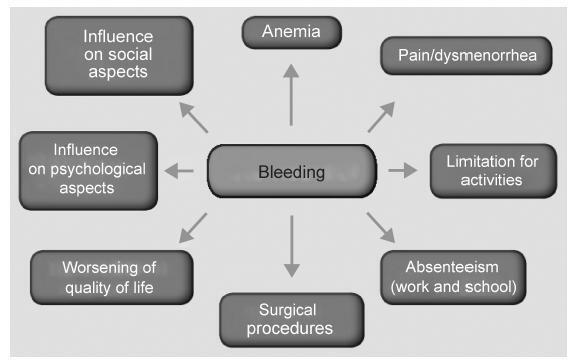-
Original Article10-03-2000
Factors Related to Obesity and Android Pattern of Body Fat Distribution in Climacteric Women
Revista Brasileira de Ginecologia e Obstetrícia. 2000;22(7):435-441
Abstract
Original ArticleFactors Related to Obesity and Android Pattern of Body Fat Distribution in Climacteric Women
Revista Brasileira de Ginecologia e Obstetrícia. 2000;22(7):435-441
DOI 10.1590/S0100-72032000000700006
Views134See morePurpose: to describe sociodemographic characteristics of a group of climacteric women in order to discover the frequency and the variables associated with obesity and android profile of body fat distribution. Methods: an observational study was carried out in 518 patients aged 45 to 65 years, in a climacterium outpatient clinic. Age, color, menopausal status, duration of menopause, physical activity, smoking status, diet, alcohol intake, personal and family antecedents of arterial hypertension, diabetes mellitus, cardiovascular disease, dyslipidemia and obesity were considered. Body mass index and the waist/hip ratio were the dependent variables. For the statistical analysis Wilcoxon test, Pearson’s correlation coefficient, with a 5% level of significance, and multivariate analysis using regression model were used. Results: more than two thirds of the participants were nonobese with an android profile and postmenopausal. One fourth had physical activity and were smokers; half reported an inadequate diet and one fifth were alcoholics. Patients with an android profile presented higher mean age than women with gynecoid pattern. Personal antecedents of obesity, arterial hypertension, diabetes and family history of diabetes were related to obesity and android pattern. Postmenopausal status was significantly associated with the android profile. Conclusions: the majority of the participants were nonobese with an android profile, white, postmenopausal, sedentary, neither smokers nor alcoholics. The main factors related to obesity and android pattern were personal antecedents of obesity, arterial hypertension, diabetes, family history of diabetes and particularly, postmenopausal status with android profile.
PlumX Metrics
- Citations
- Citation Indexes: 1
- Usage
- Full Text Views: 31913
- Abstract Views: 4689
- Captures
- Readers: 25
-
Original Article10-03-2000
Gastroschisis: Prenatal Evaluation of Prognostic Factors for Postnatal Outcome
Revista Brasileira de Ginecologia e Obstetrícia. 2000;22(7):421-428
Abstract
Original ArticleGastroschisis: Prenatal Evaluation of Prognostic Factors for Postnatal Outcome
Revista Brasileira de Ginecologia e Obstetrícia. 2000;22(7):421-428
DOI 10.1590/S0100-72032000000700004
Views105See morePurpose: to evaluate 24 cases of gastroschisis, in relation to the prognostic factors that interfered with postnatal outcome. Patients and Method: twenty-four pregnancies with fetal prenatal ultrasound diagnosis of gastroschisis, during an 8-year period, were analyzed. Gastroschisis was classified into isolated, when there were no other structural abnormalities, or associated, when other abnormalities were present. For both groups the following parameters were examined: ultrasound bowel dilatation (>18 mm), obstetric complications and postnatal outcome. Nonparametric Mann-Whitney and exact Fisher’s tests were used for statistical analyses. Results: in 9 cases (37.5%) gastroschisis was associated with other abnormalities, and in 15 cases it was isolated (62.5%). All cases of associated gastroschisis had a letal prognosis, therefore the overall mortality rate was 60.8%. In the group of isolated gastroschisis, all were born alive and were submitted to surgery, but the survival rate after surgical correction was 60%. The median gestational age at birth was 35 weeks and birth weight 2,365 grams. Premature delivery was observed in 10 cases, mainly as a consequence of obstetric complication. Two newborns were small for gestational age, and only 3 had birth weight >2,500 grams. Oligohydramnios was found in 46.6% and it was more frequent in the group of postnatal death (66.7%). Ultrasound assessment of bowel showed bowel dilatation in 86.6%, however, without relation to the prognosis and postnatal bowel findings. There was no significant difference between gestational age at birth and birth weight comparing the survivor and postnatal death groups. Conclusions: isolated gastroschisis had a better prognosis when compared to associated, therefore this prenatal differentiation is important. Isolated gastroschisis was often associated with prematurity, small birth weight and obstetric complications. Prenatal diagnosis allows better monitoring of fetal and obstetric conditions. Delivery should be at term, unless presenting with obstetric complications.
PlumX Metrics
- Citations
- Citation Indexes: 1
- Usage
- Full Text Views: 70670
- Abstract Views: 1137
- Captures
- Readers: 19
-
10-03-2000
MAIS UMA META ATINGIDA
Revista Brasileira de Ginecologia e Obstetrícia. 2000;22(7):399-399
-
07-23-2000
Isoformas de Prolactina no Fluido Folicular de Pacientes Submetidas a FIV
Revista Brasileira de Ginecologia e Obstetrícia. 2000;22(10):658-658
-
07-23-2000
Avaliação Clínica e Urodinâmica de Mulheres com Instabilidade Vesical Antes e Após Eletro-estimulação Funcional do Assoalho Pélvico
Revista Brasileira de Ginecologia e Obstetrícia. 2000;22(10):658-658
Abstract
Avaliação Clínica e Urodinâmica de Mulheres com Instabilidade Vesical Antes e Após Eletro-estimulação Funcional do Assoalho Pélvico
Revista Brasileira de Ginecologia e Obstetrícia. 2000;22(10):658-658
DOI 10.1590/S0100-72032000001000012
Views57Avaliação Clínica e Urodinâmica de Mulheres com Instabilidade Vesical Antes e Após Eletro-estimulação Funcional do Assoalho Pélvico[…]See more -
07-23-2000
Estudo Retrospectivo da Prova de Trabalho de Parto na Viabilização do Parto Vaginal em Gestantes com uma Cesárea Anterior
Revista Brasileira de Ginecologia e Obstetrícia. 2000;22(10):657-657
Abstract
Estudo Retrospectivo da Prova de Trabalho de Parto na Viabilização do Parto Vaginal em Gestantes com uma Cesárea Anterior
Revista Brasileira de Ginecologia e Obstetrícia. 2000;22(10):657-657
DOI 10.1590/S0100-72032000001000010
Views63Estudo Retrospectivo da Prova de Trabalho de Parto na Viabilização do Parto Vaginal em Gestantes com uma Cesárea Anterior[…]See more -
07-23-2000
Impacto da Ação Educativa sobre a Taxa de Abandono do Serviço de Esterilidade Conjugal da UNICAMP
Revista Brasileira de Ginecologia e Obstetrícia. 2000;22(10):657-657
Abstract
Impacto da Ação Educativa sobre a Taxa de Abandono do Serviço de Esterilidade Conjugal da UNICAMP
Revista Brasileira de Ginecologia e Obstetrícia. 2000;22(10):657-657
DOI 10.1590/S0100-72032000001000011
Views60Impacto da Ação Educativa sobre a Taxa de Abandono do Serviço de Esterilidade Conjugal da UNICAMP[…]See more
Search
Search in:
Tag Cloud
Pregnancy (252)Breast neoplasms (104)Pregnancy complications (104)Risk factors (103)Menopause (88)Ultrasonography (83)Cesarean section (78)Prenatal care (71)Endometriosis (70)Obesity (61)Infertility (57)Quality of life (55)prenatal diagnosis (51)Women's health (48)Maternal mortality (46)Postpartum period (46)Pregnant women (45)Breast (44)Prevalence (43)Uterine cervical neoplasms (43)





